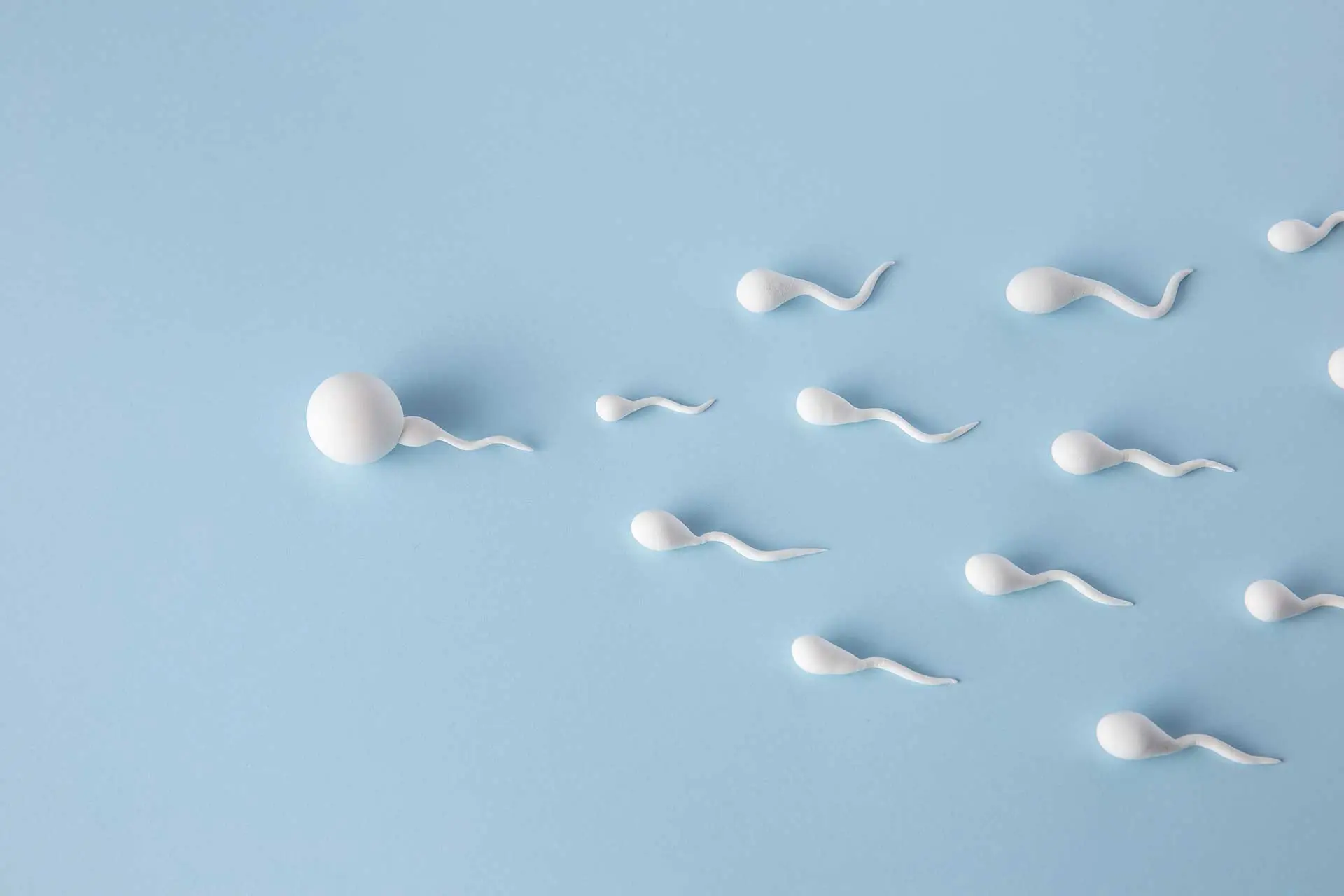IranHealthAgency explains the factors that define sperm quality and how they influence treatment outcomes.
For couples pursuing IVF in Iran, comprehensive assessments and expert guidance ensure that all aspects of sperm quality are considered, optimizing the chances of a healthy and successful pregnancy.
Fertility Type: What type of sperm is most fertile?
When talking about the fertility type of sperm and figuring out which type is the most fertile, it is essential to look at different aspects of semen quality, which are crucial for male fertility.
- The most fertile sperm are concentrated, move quickly, have a specific shape, and are alive. A large number of sperm in a sample of semen gives a much better chance of fertilization, but this is not the only factor that determines pregnancy.
- Sperm motility, or the ability of sperm to swim quickly toward the egg, is also very important. People believe that sperm with progressive motility are more fertile. We also examine the sperm morphology, referring to the size and form of the sperm cells. Sperm with normal morphology are more likely to reach an egg and fertilize it. Lastly, sperm viability is significant
- Sperm viability indicates how many live sperm are present in a sample. A higher viability value means the sample has a higher chance of being fertile.
Overall, the most fertile sperm are those that do well in all of these areas. This means they have the best chance of getting and fertilizing an egg, which leads to a good pregnancy. (1)
Sperm Testing: How do you assess the best quality of sperm for IVF?
Sperm testing is a critical step in the infertility assessment process, particularly when preparing for in vitro fertilization (IVF). A microscope will examine the sample you provided through ejaculation in a sterile environment to assess several important qualities that can affect fertility.
- Sperm count: We count the number of sperm in the semen sample. For most people, a sperm count of 15 million or more per millilitre of semen is safe.
- Motility: We record the percentage of moving sperm. A healthy sperm has a movement rate of at least 40%.
- Morphology: This checks out the sperm’s size and form. Because it can’t fertilize the egg, its abnormal shape may signify fertility problems.
- Volume: This measures the amount of semen a man produces during ejaculation.
- PH: This method tests the sperm’s acidity.
If sperm testing results are low and there are problems with men’s sperm; certain options become available; one of these options is sperm donation.
Sperm Purchase or Donate: What kind of sperm do you buy for IVF?
As we said, when a couple is straight and has male factor infertility (Donor sperm is also often used to help single women and gay couples get pregnant), using donor sperm may be the best way to get pregnant through IVF.
-
Type of Sperm Donor
You can pick a sperm donor from a sperm bank who is nameless or someone you know, like a friend or family member. Information about a sperm donor’s characteristics is available at sperm banks. If you’re using a known donor, it’s important to ensure they have no genetic or infectious diseases.
-
Quality of Sperm
Sperm banks analyze sperm to check things like concentration, motility, and shape to determine their quality. People who want to use IVF should get sperm with at least 5 million motile sperm per millilitre (MOT5 or higher).
-
Getting Sperm Ready
Sperm can be given in several different forms, including:
For example, there are IUI straws that contain 0.5 mL of sperm with different levels of mobility. These are used for intrauterine insemination (IUI) or in vitro fertilization (IVF). There are also ICI straws that contain higher levels of sperm mobility, often used for IVF. The number of straws or vials needed depends on the specific situation and how many IVF attempts are planned.
Is sperm donation cheaper than fertility treatments?
No, sperm donation itself is not cheaper than fertility treatments that utilize donor sperm. The following are some important aspects of the connected expenses:
- Purchasing donor sperm from a sperm bank typically costs $800 to $1,300 per vial/straw, excluding shipping fees.
- This cost is in addition to the fees for the actual fertility treatment procedure, such as intrauterine insemination (IUI) or in vitro fertilization (IVF).
- For IUI using donor sperm, the total cost per cycle can range from around $300 to $4,000, depending on the clinic and whether fertility medications are used.
- For IVF using donor sperm, the total cost per cycle is generally between $6,500 and $8,000, including the price of the sperm, IVF procedures, medications, and additional fees.
- Some clinics offer discounted multi-cycle packages for IUI or IVF with donor sperm.
Fresh vs. Donor Sperm: Is fresh sperm better for IVF?
After all this, the main question arises: Is IVF more successful with donor sperm?
We don’t know much about the differences between fresh and frozen donor sperm in IVF. However, the data shows that you can use sperm that is either fresh or frozen. Other factors that could potentially significantly impact the outcomes of IVF include the following: The age of the individuals who provide ovum and sperm could be a significant factor.
Researchers found that using fresh sperm for IUI cycles with drugs that induce ovulation resulted in a significantly higher rate of live births and pregnancies than using frozen sperm. (4)
Maximizing Sperm: How to Maximize the Best Sperm?
In the end, you may ask for tips to maximize sperm quality to avoid some problems; though there isn’t a magic bullet to create the “best” sperm, there are several healthy lifestyle decisions that can increase both the amount and quality of sperm. Consider the following key items.
Here are some valuable tips:
- Try to stay at a good weight. According to some studies, having a higher body mass index (BMI) is linked to having fewer sperm and fewer sperm moving.
- Have a healthy meal plan. An abundance of fruits and veggies, which are highly antioxidant and may help enhance sperm health, is recommended.
- Get rid of stress. Hormones that are needed to make sperm can’t work correctly when you’re stressed.
Practice Safe Sex: Sexually transmitted infections (STIs) can damage sperm production.
- Take action. Powerful antioxidant enzymes can be raised through moderate exercise, which can help protect sperm.
Conclusion
Each step in the in vitro fertilization (IVF) process must be carefully considered to increase the chances of getting pregnant. The collection and preparation of the sperm determine the number of fertilized eggs and the baby’s growth. Andrologists and patients must follow clinic rules during testicular sperm extraction (TSE) and micro-epididymal sperm aspiration (MESA), which are both delicate operations. Remember to talk to your doctor and follow his advice.
FAQ:
Does the egg choose the best sperm?
Human eggs contain chemicals that make sperm want to mate with them. A new study from the University of Manchester, Stockholm University, and the University of Manchester reveals that eggs use these chemicals to select sperm. Different women’s eggs attract men’s sperm, but not always those of their partners.
Does fresh sperm cause poor embryo quality?
Overall, even before the embryonic genome turned on, there was a negative link between the quality of the sperm and the development of the embryo. This suggests that sperm can affect embryogenesis at a very early stage.
Does IVF pick sick embryos?
Experts and parents wonder if IVF picks dangerous embryos. Sperm fertilizes eggs and transfers embryos to the uterus in IVF. Professionals evaluate embryo viability and development before implantation. However, “sick embryos” may have genetic or chromosomal defects that hamper development.
New reproductive technologies, like PGD and PGS, reduce aneuploid embryo transfer. Using genetic data, embryologists can avoid “selecting” dangerous IVF embryos.
Can you do IVF with nasty sperm?
Yes, it is still possible to get pregnant even if your sperm isn’t working right. But if there is a lot of sperm with strange shapes, it could mean that there are other problems with the sperm, like a low sperm count or issues with how they move.
Which sperm is best?
Healthy sperm have round heads and long, muscular tails. Sperm with more shape are more likely to reach an egg.



